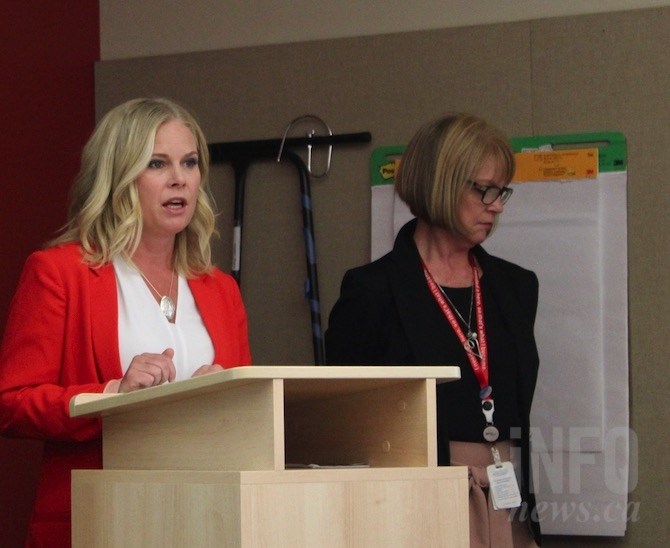
Danielle Cameron, left, spoke to Kelowna City Council on homelessness in June and again today. Deborah Preston also spoke.
(ROB MUNRO / iNFOnews.ca)
October 21, 2019 - 3:00 PM
Health authorities have yet to find the answers to Kelowna’s opioid crisis.
That’s one clear message from a presentation by Interior Health to Kelowna city council today, Oct. 21.
“We are facing a very complex problem,” Danielle Cameron, health and substance use administrator for Interior Health, told council. “The solutions to the problem are not simple and nobody has the answers otherwise we would have figured it out by now.”
It was back in 2016 when the opioid crisis was first labelled as such and various agencies did what they could to cope but it took a couple of years for agencies like Interior Health to realize doing the same old things didn’t necessarily work.
“In 2018, we started working differently in terms of collaborating and making sure we were coordinated,” Cameron said.
That process is still underway as Interior Health works with Journey Home, B.C. Housing and other agencies to grapple with what appears to be a growing problem of homelessness and addiction as more and more people are camping out on Leon Avenue because the two shelters there are full.
Key to making progress is a “systems map” that will more clearly identify who and how many people are homeless and what services they need. That’s expected to be complete, along with a plan of action, by the end of March.
That doesn’t mean nothing has happened. Things like mobile safe injection sites and providing safe alternatives to opioids (called Opioid Agonist Treatment) have helped save lives but there are still gaps that people fall through.
Those include a shortage of treatment and recovery beds but also the fact that more and more people just can’t find affordable housing – to the point where some who are not using illegal drugs start to consume as a coping strategy after losing their homes.
“People are really struggling to find housing,” Cameron said. “You see that on Leon. Safe, affordable, stable housing is really hard to find.”
Cameron did provide council with a list of services provided in Kelowna. It’s not yet on the Interior Health website but can be viewed here starting at page 7.
But, clearly, some of the efforts already underway are not sitting well with councillors.
Coun. Mohini Singh complained about needles being distributed to drug users who go off site to shoot up, leaving behind their used needles.
“I have huge concerns about this,” she said. “You should go in and inject under supervision, making sure they’re not killing themselves.”
Cameron noted that users are talked to about proper needle disposal but are not required to inject on site.
There is also huge concern in the community about a lack of “wrap around services” for supportive housing projects.
Deborah Preston, community health services coordinator for Interior Health, said that’s a misleading term. In fact, she said, it should be referred to as “layered services.”
That means people are housed and allowed to use illegal substances. Once they have a safe place to live, they often look for treatment so outreach workers can direct them to things like the opioid substitute programs.
To contact a reporter for this story, email Rob Munro or call 250-808-0143 or email the editor. You can also submit photos, videos or news tips to the newsroom and be entered to win a monthly prize draw.
We welcome your comments and opinions on our stories but play nice. We won't censor or delete comments unless they contain off-topic statements or links, unnecessary vulgarity, false facts, spam or obviously fake profiles. If you have any concerns about what you see in comments, email the editor in the link above.
News from © iNFOnews, 2019